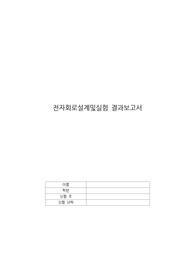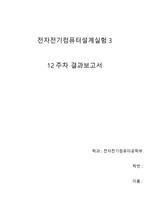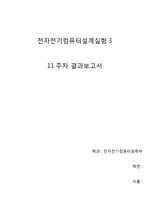

-
미리보기
소개
"전자회로실험 A+ 10주차 결과보고서(BJT Amp Biasing)"에 대한 내용입니다.목차
1. 실험목표
2. 실험과정
3. 실험결과
4. 실험결과 사진
5. PSPICE 결과
6. PSPICE 사진
7. 분석 및 토의본문내용
1. 실험목표
-Measure the frequency response of common emitter amplifier.
-Observe the effect of emitter bypass capacitor on the amplifier gain.
-Measure the input impedance and output impedance of CE amplifier.
2. 실험과정
(1) Frequency Response of Common Emitter Amplifier
1. Construct the common emitter amplifier as shown in Figure 7.1. Use a RC = 1 kΩ, RB = 560 Ω, and VCC = 9 V.
2. For the input signal, use a 25 mV peak-to-peak sine wave with a DC offset of 650 mV. This signal is both VBIAS and vin combined, and will be referred to as vIN.
3. Using the oscilloscope, plot vIN on Channel 2 and vOUT on Channel 1. Take a picture of the waveform on the oscilloscope and attach it to your report.
4. Record the magnitude and phase of out/vin as measured from the oscilloscope in table 7.1.
5. Using the techniques mentioned above, create the Bode magnitude and phase plots. To save time, sweep the frequency in decades first (i.e. increment by factors of 10) and do not exceed 2 MHz for this circuit. Then, take more measurements in frequency ranges where the poles are located.
6. Find the frequency where the gain decreases from its DC value by 3 dB; this frequency is called the dominant pole of the amplifier. What is the phase at this frequency? Record them in table 7.1. Is the phase consistent with the magnitude? (Recall that at the -3 dB point, the phase should drop from its DC value by 45 degrees.)참고자료
· 없음태그
-
자료후기
-
자주묻는질문의 답변을 확인해 주세요

꼭 알아주세요
-
자료의 정보 및 내용의 진실성에 대하여 해피캠퍼스는 보증하지 않으며, 해당 정보 및 게시물 저작권과 기타 법적 책임은 자료 등록자에게 있습니다.
자료 및 게시물 내용의 불법적 이용, 무단 전재∙배포는 금지되어 있습니다.
저작권침해, 명예훼손 등 분쟁 요소 발견 시 고객센터의 저작권침해 신고센터를 이용해 주시기 바랍니다. -
해피캠퍼스는 구매자와 판매자 모두가 만족하는 서비스가 되도록 노력하고 있으며, 아래의 4가지 자료환불 조건을 꼭 확인해주시기 바랍니다.
파일오류 중복자료 저작권 없음 설명과 실제 내용 불일치 파일의 다운로드가 제대로 되지 않거나 파일형식에 맞는 프로그램으로 정상 작동하지 않는 경우 다른 자료와 70% 이상 내용이 일치하는 경우 (중복임을 확인할 수 있는 근거 필요함) 인터넷의 다른 사이트, 연구기관, 학교, 서적 등의 자료를 도용한 경우 자료의 설명과 실제 자료의 내용이 일치하지 않는 경우
찾으시던 자료가 아닌가요?
지금 보는 자료와 연관되어 있어요!
문서 초안을 생성해주는 EasyAI






